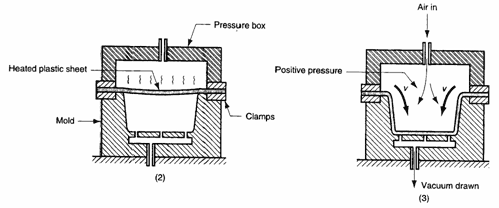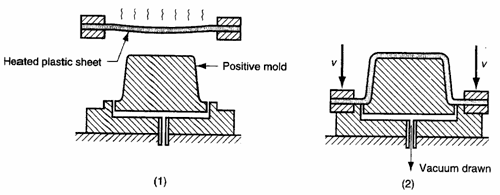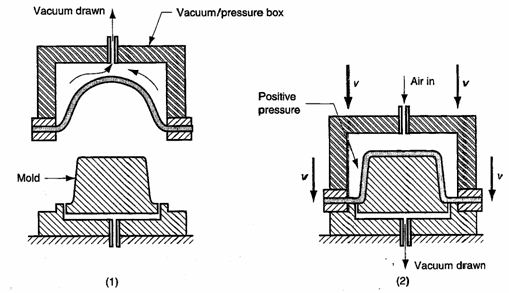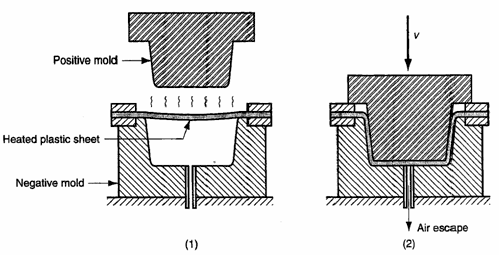Procesado de polímeros
21 12 2011Vacuum Thermoforming (origen http://www.sinotech.com/thermoforming.html)
The earliest method was vacuum thermoforming (called simply vacuum forming when it was developed in the 1950s), in which negative pressure is used to draw a preheated sheet into a mold cavity. The process is explained below in its most basic form. The holes for drawing the vacuum in the mold are on the order of 0.8 mm (0.031 in.) in diameter, so their effect on the plastic surface is minor.
Vacuum thermoforming: (1) a flat plastic sheet is softened by heating; (2) the softened sheet is placed over a concave mold cavity; (3) a vacuum draws the sheet into the cavity; and (4) the plastic hardens on contact with the cold mold surface, and the part is removed and subsequently trimmed from the web.

Pressure Thermoforming
An alternative to vacuum forming involves positive pressure to force the heated plastic into the mold cavity. This is called pressure thermoforming or blow forming its advantage over vacuum forming is that higher pressures can be developed because the latter is limited to a theoretical maximum of 1 atm. Blow-forming pressures of 3 to 4 atm are common. The process sequence is similar to the previous, the difference being that the sheet is pressurized from above into the mold cavity. Vent holes are provided in the mold to exhaust the trapped air. The forming portion of the sequence (steps 2 and 3) is illustrated below.

Pressure thermoforming. The sequence is similar to previous figure, the difference being: (2) sheet is placed over a mold cavity; and (3) positive pressure forces the sheet into the cavity.
At this point it is useful to distinguish between negative and positive molds. The molds shown above are negative molds because they have concave cavities. A positive mold has a convex shape. Both types are used in thermoforming. In the case of the positive mold, the heated sheet is draped over the convex form and negative or positive pressure is used to force the plastic against the mold surface. The positive mold is shown in below for the case of vacuum forming.

Use of a positive mold in vacuum thermoforming: (1) the heated plastic sheet is positioned above the convex mold and (2) the clamp is lowered into position draping the sheet over the mold as a vacuum forces the sheet against the mold surface.
The difference between positive and negative molds may seem unimportant, since the part shapes are virtually identical, as shown in the diagrams. However, if the part is drawn into the negative mold, then its exterior surface will have the exact surface contour of the mold cavity. The inside surface will be an approximation of the contour and will possess a finish corresponding to that of the starting sheet. By contrast, if the sheet is draped over a positive mold, then its interior surface will be identical to that of the convex mold; and its outside surface will follow approximately. Depending on the requirements of the product, this distinction might be important.
Another difference is in the thinning of the plastic sheet, one of the problems in thermoforming. Unless the contour of the mold is very shallow, there will be significant thinning of the sheet as it is stretched to conform to the mold contour. Positive and negative molds produce a different pattern of thinning in a given part. Consider our tub-shaped part as an example. In the positive mold, as the sheet is draped over the convex form, the portion making contact with the top surface (corresponding to the base of the tub) solidifies quickly and experiences virtually no stretching. This results in a thick base but with significant thinning in the walls of the tub. By contrast, a negative mold results in a more even distribution of stretching and thinning in the sheet before contact is made with the cold surface.
A way to improve the thinning distribution with a positive mold is to prestretch the sheet before draping it over the convex form. As shown in figure below, the heated plastic sheet is stretched uniformly by vacuum pressure into a spherical shape prior to drawing it over the mold.

Prestretching the sheet in (1) prior to draping and vacuuming it over a positive mold.
The first step depicted in frame (1) of the figure above can be utilized alone as a method to produce globe-shaped parts such as skylight windows and transparent domes. In the process, closely controlled air pressure is applied to inflate the soft sheet. The pressure is maintained until the blown shape has solidified.
Mechanical Thermoforming
The third method, called mechanical thermoforming, uses matching positive and negative molds that are brought together against the heated plastic sheet, forcing it to assume their shape. In the pure mechanical forming method, air pressure (positive or negative) is not used at all. The process is illustrated below. Its advantages are better dimensional control and the opportunity for surface detailing on both sides of the part. The disadvantage is that two mold halves are required; the molds for the other two methods are therefore less costly.

Applications. Thermoforming is a secondary shaping process, the primary process being that which produces the sheet or film. Only thermoplastics can be thermoformed, since extruded sheets of thermosetting or elastomeric polymers have already been crosss-linked and cannot be softened by reheating. Common thermoforming plastics are polystyrene, cellulose acetate and cellulose acetate butyrate, ABS, PVC, acrylic (polymethylmethacrylate), polyethylene, and polypropylene.
Mass production thermoforming operations are performed in the packaging industry. The starting sheet or film is rapidly fed through a heating chamber and then mechanically formed into the desired shape. The operations are often designed to produce multiple parts with each stroke of the press using molds with multiple punches and cavities. In some cases, the extrusion machine that produces the sheet or film is located directly upstream from the thermoforming process, thereby eliminating the need to reheat the plastic. And for best efficiency, the filling process to put the consumable food item into the container is placed immediately downstream from thermoforming.
Thin film packaging items that are mass produced by thermoforming include blister packs and skin packs. They offer an attractive way to display certain commodity products such as cosmetics, toiletries, small tools, and fasteners (nails, screws, etc.). Thermoforming applications include large parts that can be produced from thicker sheet stock. Examples include covers for business machines, boat hulls, shower stalls, diffusers for lights, advertising displays and signs, bathtubs, and certain toys.